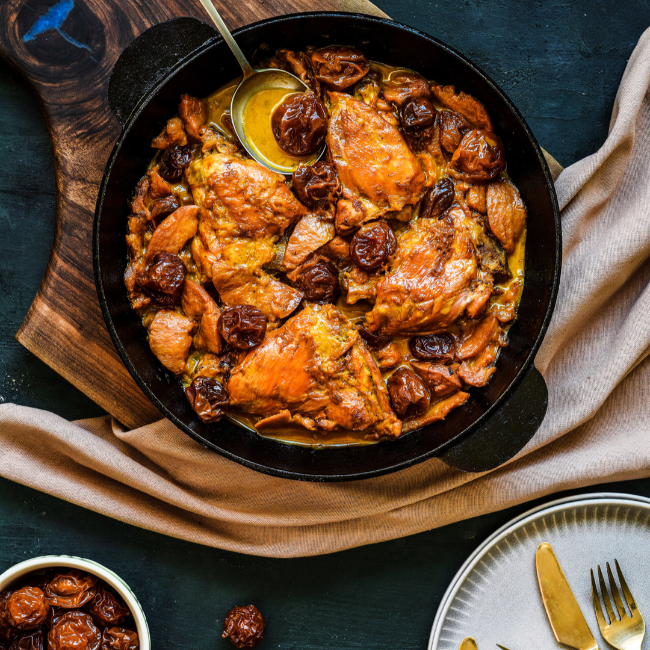
Persian Stew with Plum & Quince (Khoresh-e Beh)
Persian Stew with Plum & Quince (Khoresh-e Beh)
Among all of the popular fruit stews from Iran, this Quince stew (Khoresh-e-Beh) is perhaps the most famous of them all. The dish originated from the city of Esfahan, where some of the best quince in the world is grown. It is vey popular ingredient in Persian cuisine, whether as Khoresh-e-Beh, a rich and aromatic quince preserve or even a warming quince tea.
The combination of sweet and sour flavours in this warming stew will make it one of your go-to comfort dishes during the winter time. It’s a great dish to serve when you have guests coming as the ambrosial aroma that swirls around your kitchen as the quince cooks is certain to have their mouth’s watering.

What you should know about quince:
- Quince is native to Western Asia, Iran and Greece. It looks quite similar to a pear with little more bumpy and round appearance. The heady aroma of a quince has hints of apple, pear and citrus. When cooked, it’s sour astringent flavour and grainy textured flesh changes to sweet and slightly spiced with a richer perfume and soft texture. Unlike most other fruits, quinces are rarely eaten raw.
- Because of its popularity, Quince is farmed widely in Iran and is available from early autumn to early spring however, here in Canada you can find it around December up until March.
- Quinces are extremely nutritious. They are very low in calories and contain vitamin C, zinc, iron, copper, potassium, magnesium and dietary fibre. The seed, fruit and leaves of the plant are all used in herbal medicine for respiratory illnesses, digestive issues, stomach ulcers, lowering blood pressure and it is used as a gastrointestinal aid.
- The flavour is similar to it’s aroma, and it has been compared to an elderflower or muscat grape. Quince’s assertive flavours and floral aroma pairs incredibly well with a variety of ingredients such as almonds, cinnamon, vanilla, cream and salty cheese and meats like prosciutto, Stilton, and Parmigiano-Reggiano.
How to cook quince:
There are a great deal of ways to cook quince; you can roast them, poach them, bake them into pies,tarts, cakes and crisps. Because of their high quantity of pectin, they're commonly turned into preserves, jellies jam, and quince cheese (also known as quince paste) The Spanish love to snack on membrillo (the Spanish name for quince paste) served with manchego.
What is Khoresh-e-Beh?
Quince has been used extensively in Persian cuisine because of its sweet aroma and unique flavour. It’s made its way into Western cuisine over the years as it has become increasingly easier to find. Khoresh (stew) is a huge part of Persian cuisine and is usually served alongside Persian rice.
Here in Canada, most big grocery stores sell quince around to March while in Iran, quince is so popular that it is farmed extensively and its availability stretches from early autumn to early spring. Hence why Khoresh-e-Beh is considered a late autumn/early winter dish.
Can I make vegetarian Khoresh-e-beh?
The main flavour from this dish comes from the quince and the chicken is merely there to compliment it. You can definitely leave the meat out and instead of using water, use vegetable stock to give it a more rich flavour.
How to make plum & quince stew:
Prepare the quince: Peel the quince using a sharp knife and cut them into quarters. Spoon out the seeds and hard white part of the middle. Slice the quince in approximately 1cm thickness.
Sauté the onion and quince: Firstly sauté the chopped onion alone for about 5 minutes then add sliced quince and sauté for 4-5 minutes. Remove them from the skillet.
Season the chicken thighs and sear: Generously season the chicken thighs with salt and pepper and place each thigh into the skillet. Sear thighs for 4 to 5 minutes Flip each piece no continue to sear for another 4-5 minutes.
Re-introduce the quince mix: Add the quince mix back into the skillet and scatter with soaked plums. Add the saffron powder, cinnamon, sugar and water.
Bake the stew: Transfer the skillet to the oven and bake the thighs for 20 minutes or until cooked through.
Category
Stew
Main Course
Servings
4
Prep Time
20 minutes
Cook Time
20 minutes
Author:
Gillian Brady

Ingredients
1 large onion
2 large quince, peeled, cored and sliced
-
20 dried torghabeh plums, soaked at least 1 hour
4-6 chicken thighs, skinless
1-2 tbsp sugar, optional
1/4 tsp saffron powder
2 tbsp vegetable oil
1 cup water
1 tsp salt
1/4 tsp black pepper
-
1/4 tsp cinnamon powder
Directions
Preheat oven to 350F
Place a large skillet over medium-high heat and add the oil. Sauté chopped onion for about 5 minutes, add sliced quince and sauté for 4-5 mins.
Remove sautéed onion and quince from the pan. Generously season chicken thighs with salt and pepper and place each chicken thigh into skillet. Sear thighs for 4 to 5 minutes. Flip each piece of chicken and continue to sear for an additional 4 to 5 minutes.
Add quince mix back, scatter with soaked plums.
Grind up your saffron using a pestle and mortar. Add the saffron, cinnamon, sugar and water.
Transfer skillet to an oven and bake thighs for about 20 minutes or until cooked through.
Stay updated!
Sign up to get email updates
 Skip to content
Skip to content



